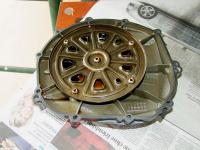The cover one removes to access the clutch includes parts labeled "damper" and "damper cover".
What's the purpose of these parts?
Obviously they can't physically touch the clutch but they are very close.
It would appear that some design effort was involved for the damper. There's some asymmetry to the part.
What's the purpose of these parts?
Obviously they can't physically touch the clutch but they are very close.
It would appear that some design effort was involved for the damper. There's some asymmetry to the part.




